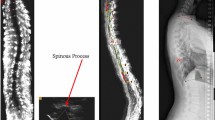Abstract
Study Design
Retrospective reliability study.
Objectives
To investigate the intra- and interrater reliability of Cobb angle measurements on the plane of maximum curvature (PMC) using ultrasound (US) images on children with adolescent idiopathic scoliosis (AIS).
Summary of Background Data
Cobb angle measurement on posteroanterior (PA) radiographs is the gold standard to assess curve severity. However, the PA Cobb angle does not reflect the true three-dimensional deformity.
Methods
One hundred one children with AIS (87 F; 14 M) (age: 13.7 ± 1.7 years) were recruited and 157 curves were recorded by clinicians on radiographs. Three raters, R1, R2, and R3 with 0, 4, and 20+ years of experience, respectively, measured the PA Cobb, vertebral axial rotation (VAR), PMC Cobb, and PMC orientations on US images. The true PMC orientations were determined using 3D reconstructions on the PA and lateral EOS radiographs. The reliability of R1 measurements on PMC orientations were validated using intermethod (US vs. EOS measurements) with the intraclass correlation coefficients (ICCs). Inter- and intrarater reliabilities, standard error measurements, and Bland-Altman’s bias were used to report the PMC Cobb and VAR measurements.
Results
Intermethod, inter-, and intrarater ICC(2,1) values for all reliability assessments were greater than 0.9. The mean absolute differences and the standard error measurements for both PMC Cobb and VAR were less than 4° and 0.5°, respectively. The PMC orientation was strongly correlated (r2 = 0.88) between both measurement modalities. There appeared to be a positive association between the difference of PMC and PA Cobb when the PA Cobb and the maximum VAR were greater than 30° and 14°, respectively.
Conclusion
The PMC Cobb and VAR can be measured reliably on US images. Future studies should validate the PMC Cobb angle and to include a wider Cobb angle range on participants.
Similar content being viewed by others
References
Cobb JR. Outline for the study of scoliosis. Am Acad Orthop Surg Instr Course Lect 1948;5:261–75.
Katz DE, Richards BS, Browne RH, et al. A comparison between the Boston brace and the Charleston bending brace in adolescent idiopathic scoliosis. Spine 1997;22:1302–12.
Helenius I, Remes V, Yrjonen T, et al. Harrington and Cotrel-Dubousset instrumentation in adolescent idiopathic scoliosis. Long-term functional and radiographic outcomes. J Bone Joint Surg Am 2003;85:2303–9.
Tan KJ, Moe MM, Vaithinathan R, et al. Curve progression in idiopathic scoliosis: follow-up study to skeletal maturity. Spine 2009;34:697–700.
Wills BP, Auerbach JD, Zhu X, et al. Comparison of Cobb angle measurement of scoliosis radiographs with preselected end vertebrae: traditional versus digital acquisition. Spine 2007;32:98–105.
Stokes IAF. Three-dimensional terminology of spinal deformity. A report presented to the Scoliosis Research Society by the Scoliosis Research Society Working Group on 3-D terminology of spinal deformity. Spine 1994;18:236–48.
Vrtovec T, Vengust R, Likar B, et al. Analysis of four manual and a computerized method for measuring axial vertebral rotation in computed tomography images. Spine 2010;20:535–41.
Gocen S, Havitcioglu H. Effect of rotation on frontal plane deformity in idiopathic scoliosis. Orthopedics 2001;24:265–8.
Illés T, Somoskeöy S. Comparison of scoliosis measurements based on three-dimensional vertebra vectors and conventional two-dimensional measurements: advantages in evaluation of prognosis and surgical results. Eur Spine J 2013;22:1255–63.
Labelle H, Bellefleur C, Joncas J, et al. Preliminary evaluation of a computer-assisted tool for the design and adjustment of braces in idiopathic scoliosis: a prospective and randomized study. Spine 2007;32:835–43.
Nault ML, Mac-Thiong JM, Roy-Beaudry M, et al. Three-dimensional spinal morphology can differentiate between progressive and nonprogressive patients with adolescent idiopathic scoliosis at the initial presentation: a prospective study. Spine 2014;39:601–6.
Kadoury S, Labelle H. Classification of three-dimensional thoracic deformities in adolescent idiopathic scoliosis from a multivariate analysis. Eur Spine J 2012;21:40–9.
Purnama KE, Wilkinson MH, Veldhuizen AG, et al. Ultrasound imaging for human spine: imaging and analysis. Int J CARS 2007;2: S114–6.
Nguyen DV, Vo QN, Le LH, et al. Validation of 3D surface reconstruction of vertebrae and spinal column using 3D ultrasound data—a pilot study. Med Eng Phys 2015;37:239–44.
Chen W, Lou EHM, Le LH. Ultrasound imaging of spinal vertebrae to study scoliosis. Open J Acoust 2012;2:95–103.
Vo QN, Lou EH, Le LH. 3D ultrasound imaging method to assess the true spinal deformity. In: Conf Proc IEEE Eng Med Biol Soc; Milan, Italy, Aug 25–29, 2015 2015. p. 1540–3.
Chen W, Lou EH, Zhang PQ, et al. Reliability of assessing the coronal curvature of children with scoliosis by using ultrasound images. J Child Orthop 2013;7:521–9.
Zheng R, Chan AC, Chen W, et al. Intra- and inter-rater reliability of coronal curvature measurement for adolescent idiopathic scoliosis using ultrasonic imaging method—a pilot study. Spine Deform 2015;3: 151–8.
Wang Q, Li M, Lam TP, et al. Validity study of vertebral rotation measurement using three-dimensional ultrasound in adolescent idiopathic scoliosis. Ultrasound Med Biol 2016;421: 1473–81.
Chen W, Le LH, Lou EHM. Reliability of axial vertebral rotation measurements of adolescent idiopathic scoliosis using the center of lamina method on ultrasound images: in vitro and in vivo study. Eur Spine J 2016;25:3265–73.
Stratford PW, Goldsmith CH. Use of standard error as a reliability index of interest: an applied example using elbow flexor strength data. Phys Ther 1997;77:745–50.
Portney LG, Watkins MP. Foundations of clinical research. Upper Saddle River, NJ: Pearson/Prentice Hall; 1993.
Currier P. Elements of research in physical therapy. Baltimore, MD: Williams & Wilkins; 1990.
Bland JM, Altman DG. Measuring agreement in method comparison studies. Stat Methods Med Res 1999;8:135–60.
Carpineta L, Labelle H. Evidence of three-dimensional variability in scoliotic curves. Clin Orthop 2003;412:139–48.
Author information
Authors and Affiliations
Corresponding author
Additional information
Author disclosures: ST (none), RZ (none), DLH (none), EL (none).
Funding Sources: Women and Children’s Health Research Institute (RES0014582), and Scoliosis Research Society (RES0024516).
Ethics approval was granted from the local health research ethics board.
Rights and permissions
About this article
Cite this article
Trac, S., Zheng, R., Hill, D.L. et al. Intra- and Interrater Reliability of Cobb Angle Measurements on the Plane of Maximum Curvature Using Ultrasound Imaging Method. Spine Deform 7, 18–26 (2019). https://doi.org/10.1016/j.jspd.2018.06.015
Received:
Revised:
Accepted:
Published:
Issue Date:
DOI: https://doi.org/10.1016/j.jspd.2018.06.015




